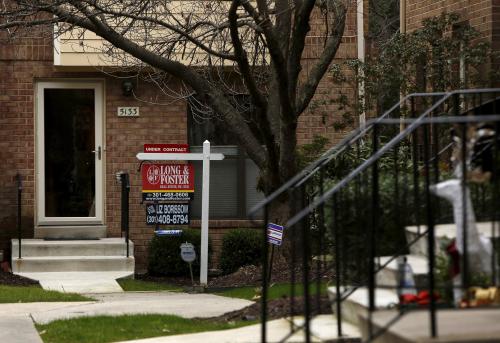American families have been feeling the pinch of rising housing costs for several years. State and federal policymakers have therefore started to propose new interventions to help. Senators Kamala Harris and Cory Booker—both representing states with high housing costs and both presumed Democratic presidential candidates—have put forward separate proposals for a federal tax credit for cost-burdened renters. Senator Booker’s bill also addresses supply constraints by proposing that local governments would have to make their zoning more growth-friendly in order to receive federal housing funds. This past spring, California state Senator Scott Wiener caused seismic ripples in the Golden State’s politics by proposing to override local zoning and allow higher density development around transit stations throughout the state. Housing issues will be on state ballots this November, including a referendum to expand rent control in California and New York gubernatorial candidate Cynthia Nixon’s proposed tenant protections.
These proposals draw more attention to housing affordability. Yet the suggested policies are mostly partial fixes that do not address the underlying problems in U.S. housing markets and policies. In two previous pieces, I have outlined broad housing policy goals and discussed limitations of our current policies. This final piece in the series offers some recommendations on how federal, state, and local governments could work together to improve the affordability, availability, and equity of housing outcomes for U.S. families.
Level the playing field between renters and owners.
Current policies are heavily stacked in favor of owners, from federal tax subsidies for homeowners to local zoning that favors single-family houses over apartments. Using public policy to penalize tenure choice is both unfair and economically inefficient. Most Americans will rent homes at some point in their lives—and today’s young people are delaying homeownership longer than their parents did. Renting allows more geographic mobility, which is especially important for young households still moving around for work or before settling into permanent family arrangements. Senior households may choose to downsize or get rid of the home maintenance burden in later years. Moreover, a tax code that gives preference to wealth-building through homeownership compared with other financial assets penalizes families who live in regions where house prices are stable or declining over time. This includes many small towns and rural areas, as well as some big cities.
A key part of leveling the playing field is eliminating preferences for homeownership in the federal tax code, namely the mortgage interest deduction and the capital gains exclusion for owner-occupied housing. The 2017 Tax Cuts and Jobs Act moved in this direction, by reducing the size of eligible mortgages and increasing the standard deduction. Policy experts across the political spectrum have offered detailed proposals to implement such changes.
At the local level, cities and towns should revise their land use regulation and development process to be neutral to structure type. For instance, land zoned to allow by-right development of three-story single-family homes (without requiring special reviews or conditions) should also allow by-right development of three-story apartment buildings. Requiring conditional use permits or other procedural hurdles for multifamily development but not single-family houses—a zoning trend that emerged in the 1970s—essentially discriminates against renters.
Stop strangling supply in high-demand locations.
In well-functioning housing markets, supply will expand to accommodate population and job growth. But there is widespread evidence that housing supply in some high-demand regions—like California and much of the Northeast corridor—is artificially constrained by excessive local land use regulation. Excess zoning increases housing prices by limiting the quantity of new housing and by making the development process longer, more complex, and more costly. High prices are especially tough on younger families, who earn less at the start of their careers. Because of persistent income and wealth gaps, high housing costs disproportionately hurt people of color. Excess zoning is especially prevalent in some of our most productive regions, which hurts U.S. economic growth. When housing costs rise, individual businesses have difficulty attracting and retaining workers.
Overly restrictive zoning reflects policy choices of local governments—and many of their citizens. Homeowners benefit financially from supply constraints and strenuously fight against proposed changes to their neighborhoods, hence the nickname “Not In My Backyard” (NIMBY). In some high-cost regions, pro-development “Yes In My Backyard” (YIMBY) coalitions are pushing back. Meanwhile, potential residents who are priced out of restrictively zoned communities exert no political influence over local governments.
Zoning reforms would allow communities to build more housing and to use less land per housing unit (e.g., higher density), especially near job centers and transit nodes. Building smaller, less expensive housing units, such as townhouses and apartments, would open up communities to a more economically diverse group of residents. Zoning reforms should also reduce the complexity and cost of development. A more transparent process would reduce the advantages of deep-pocketed, well-connected developers and increase the industry’s competitiveness.
Potential residents who are priced out of restrictively zoned communities exert no political influence over local governments.
State and federal governments have an interest in reducing local barriers to economic growth. Because local land use powers derive from state laws, state governments have more policy levers than the federal government to influence local decisions. One option would be to make receipt of federal and state funds conditional on improved housing production. Senator Booker’s bill, like HUD’s Affirmatively Furthering Fair Housing rule, would require local governments that receive Community Development Block Grant (CDBG) funds to “develop a strategy to support inclusive zoning policies.” The current bill has two substantial limitations. First, any financial incentives to local governments need to be tied to actual changes in the quantity and price of housing units built, not just revising zoning on paper. California already requires localities to specify a plan to “meet the housing needs of everyone in their community” in their comprehensive plan, yet those same localities continue to underprovide housing. Second, the funds used as incentives should come from programs that are widely distributed among local governments, including higher income communities. Withholding CDBG or other HUD funds could work for large urban jurisdictions, but not wealthy bedroom suburbs, who often have the most exclusionary zoning.
Help poor families bridge the gap between income and rent.
Reducing zoning constraints and building more market-rate housing will ease affordability problems for middle-class families. But the poorest 20 percent of families don’t earn enough to pay the rent on even modest apartments. Current federal assistance falls well short of helping those families afford a safe, stable, decent place to live: About one in five eligible families receive federal housing assistance. For poor families, the most direct solution to housing affordability is to supplement their incomes. This could be done by expanding existing mechanisms, such as the Earned Income Tax Credit (EITC) or housing choice vouchers, or through a refundable tax credit, as proposed by Senators Harris and Booker. Helping poor families bridge the gap between income and rent will relieve the stress of housing insecurity and enable more children to develop into productive and engaged citizens.
Housing policies alone cannot save places harmed by past policy failures.
High-cost, supply-constrained locations currently draw the most public attention. Yet some communities suffer from the reverse problem: excess housing supply, which translates into vacant housing and blighted neighborhoods. Many large cities with high vacancy rates are casualties of past policy failures, such as redlining that starved black neighborhoods of mortgage capital. Federally funded highways also contributed to the depopulation of central city neighborhoods. Excess or low-quality housing is one of many challenges for these communities. More fundamentally, they also lack strong job markets, and local governments have too little resources to provide adequate services. While past housing policy failures helped create current conditions, housing policies alone cannot reverse decades of population and economic decline. Rather, it will take sustained investments in human capital, infrastructure, and targeted economic development strategies to help people in these communities. The federal government, philanthropies, and private firms could all contribute capital and expertise.
Achieving better housing policy will require greater coordination between federal, state, and local governments. Previous battles to enact tax and zoning reforms demonstrate that the politics will not be easy. But correcting some of the dysfunction in housing markets will bring greater stability and well-being for American families and enhance the country’s future prosperity.







Commentary
Both renters and homeowners could benefit from better housing policy
August 6, 2018